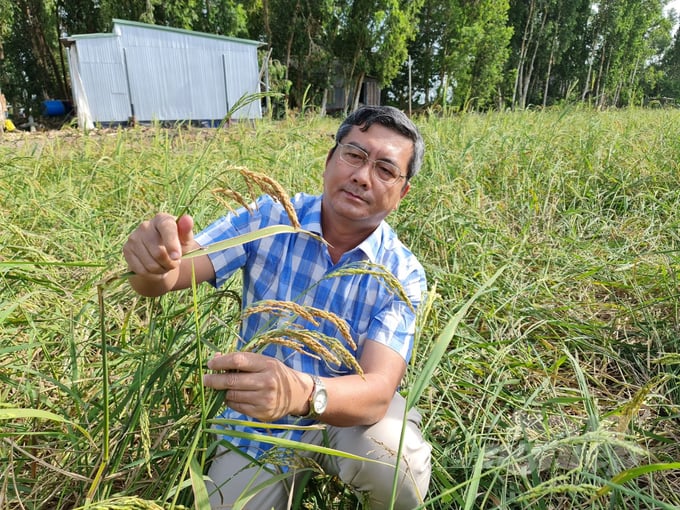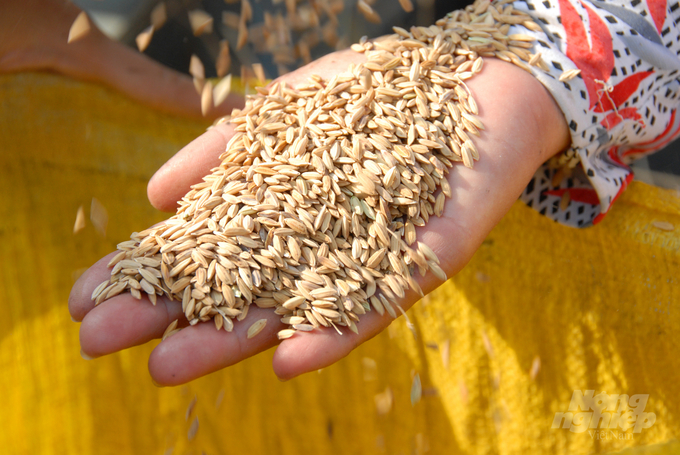
Paddy rice field in Tri Ton – An Giang district. Photo: Le Hoang Vu.
Floating season rice for an income of 5 million VND/work
On the afternoon of December 25th, Dr. Tran Minh Hai, Vice Principal of School of Agricultural and Rural Development Managers II (Ministry of Agriculture and Rural Development) the floating season rice model in Vinh Phuoc and Luong An Tra communes (District 1, Ho Chi Minh City ), Tri Ton, An Giang Province) to discuss with farmers the idea of increasing the value of the “shift from thinking about agricultural production to farming” model.
The survey points are the fields of cultivation of floating season rice varieties with Tay Dum floating season rice varieties and clipped rice varieties, comparing the efficiency between the two rice varieties. According to the proportion of farmers, this year’s floating season rice variety has a good yield (about 280-300kg/1,000m2), beautiful golden rice, while the shortened rice variety yields about 240-250kg/1,000m2, the rice grain is light dark color and quality of rice is not as good as Nang Tay Du rice variety.
In the rice harvest of the floating season in 2022, farmers in Vinh Phuoc and Luong An Tra communes increased their sowing area to 119 ha. All rice production is sold by Loc Troi Group Joint Stock Company for purchase at a fixed price of VND 16,000/kg ( via Vinh Loi Agricultural Cooperative, Vinh Phuoc Commune). As a result, farmers working together to cultivate floating rice have an income of about 5 million VND/person (1,000 m2), much higher efficiency than traditional high-yield rice cultivation.

dr Tran Minh Hai, Vice-Principal of School of Agricultural and Rural Development Managers II (MARD) visited the floating season rice model in Vinh Phuoc and Luong An Tra communes (Tri Ton district, An Giang province). Photo: Le Hoang Vu.
In the dry season, after harvesting the floating season rice, people use the available floating season rice stubble to keep growing other crops and increase income, such as: Harvest, chili costs 16.5 million dongs/labor/crop to grow, squash costs about 4.8 million dongs/labor/crop and cassava costs 3.1 million dongs/labor/crop…
In addition to economic benefits, floating rice also helps create space to store floodwater, reducing the risk of levee failure in the area. So keeping the floating rice area will help the place handle floods, especially large floods, well.
Floating season rice is rich in nutrients thanks to alluvial deposits from flooding and organic matter decomposed by long-term flooding. Soil pH is often low. Of the more than 150 species of algae that can live in floods, 24 species of blue-green algae in particular have the ability to fix nitrogen. As a result, farmers don’t need to fertilize the floating paddy fields, but also need to harvest all kinds of field fish to live naturally.
Through field visits and discussions with farmers, Dr. Tran Minh Hai that he will propose to research and organize seminars to find solutions to improve the efficiency of the floating season rice cultivation model. Accordingly, in addition to selling rice products and using the land to grow crops, farmers can participate in eco-tourism business (recreate the scenery of the floating season, experience the harvest, enjoy the specialties of the scenery…) and safely export straw to Japan, where clean straw mushrooms of high value are produced…
Preserving rice specialties in the Mekong Delta
Floating rice, cultivated by people in the Mekong Delta before 1985, is a rice variety with a unique biological mechanism. Farmers grow this rice using traditional methods, without fertilizers, pesticides, sowing in the 5th lunar month… the rice plants themselves germinate with dew and then grow.
This type of rice differs from other types of rice in particular in that it is grown “in favor of the heavens” according to the high water season. When the flood water flows in from the Mekong, where the water flows, the rice plants reach 3-5 m, go above the flood surface to grow, flower with the growing season of rice about 6 months, so it is called rice floating season.

This type of rice is grown according to the flood season “in favorable weather”. When the flood water flows in from the Mekong, where the water flows, the rice plants reach 3-5 m, go above the flood surface to grow, flower with the growing season of rice about 6 months, so it is called rice floating season. Photo: Le Hoang Vu.
In particular, the swimming season rice also creates favorable conditions for aquatic species to protect, multiply and develop during the swimming season, and helps people increase their income. When it comes to nutritional values, “natural” growth has little impact on the environment.
At present, the entire Mekong Delta region covers about 300 hectares, concentrated in the districts of Tri Ton, Cho Moi, An Phu (An Giang), Tam Nong, Thanh Binh (Dong Thap) and Tan Hung (Long An), with hundreds of tons commercial rice.
Mr. Nguyen Van Van, head of the Department of Agriculture and Rural Development of Tri Ton (An Giang) District, said: At present, floating seasonal rice is a specialty in Long Xuyen quadrangle, covering an area of about 70 hectares, mainly concentrated in Vinh Township, Phuoc and Luong An Tra.
This is a rice variety that can adapt to climate change, can be grown in deep flood plains, wherever the water rises, the rice will grow there. Most people grow floating rice without using fertilizers and pesticides, mainly relying on nature, so the rice grain is very safe. At present, the floating season rice in Tri Ton is sold by many companies with a price of VND 16,000/kg and a rice price of VND 29,000-30,000/kg.

All rice production is contracted by Loc Troi Group Joint Stock Company for purchase at a fixed price of VND 16,000/kg (through Vinh Loi Agricultural Cooperative, Vinh Phuoc Commune). Photo: Le Hoang Vu.
According to Mr. Van, for many years, the agricultural sector of Tri Ton District has been working with An Giang University to study the conservation, nurturing and improvement of locally grown rice varieties. In addition, the research team aims to strengthen farmers’ ability to apply scientific and technical advances in agriculture to commercialize floating seasonal rice and improve farmers’ income.
In recent years, the floodwaters have hardly returned, which also complicates the growth and development of floating varieties of rice, as it is attacked by pests, especially rats. But in return, the farmers produce this rice specialty without much effort and expense, but sell it at a high price. Although the yield is lower than that of high-yield rice, floating season rice is sold at a higher price because it has 5 times more vitamin E than other rice varieties.

